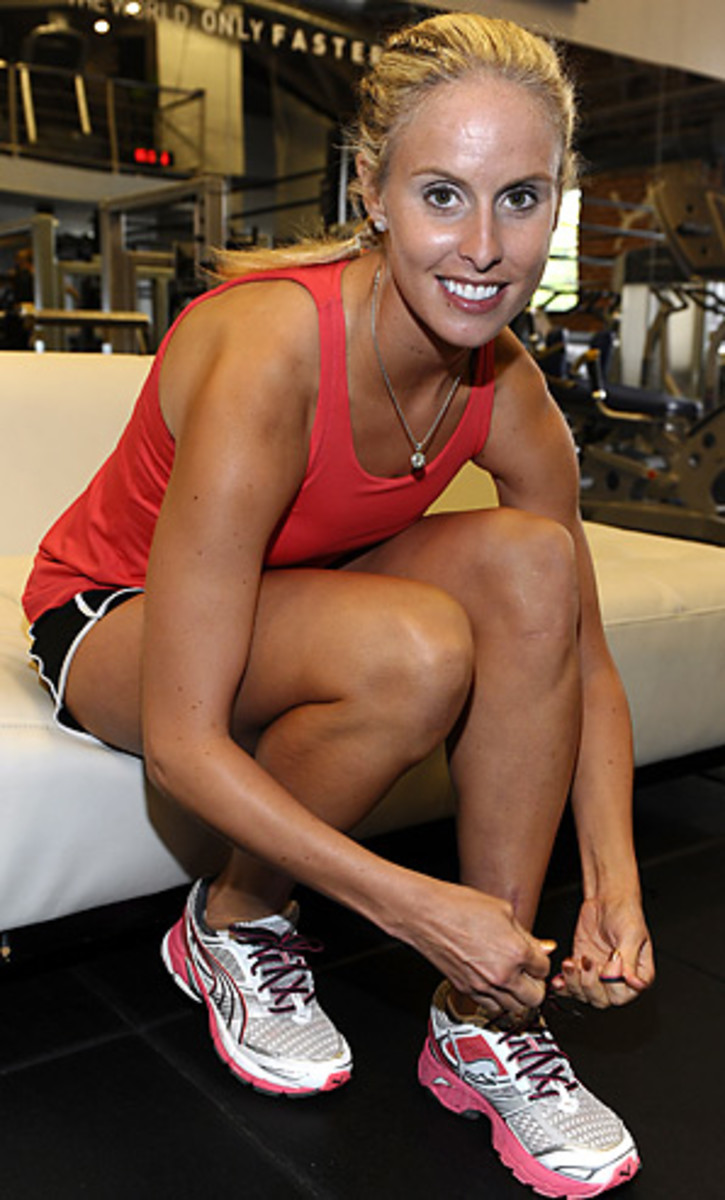Boston midfielder Leslie Osborne's marathon feels more like a sprint
An 18-mile run for the average person might sound like driving the streets of New York City during rush hour. Eventually you will reach your destination, but you might be better off avoiding the frustration. But runs of six miles, 10 miles and even 18 miles have become routine for Boston Breakers defensive midfielder Leslie Osborne, who will run the New York City Marathon on Sunday.
Unlike most participants, Osborne did not have to qualify for the New York City Marathon. She is one of 40 people running for Grassroot Soccer, a charitable organization founded by former Survivor reality TV show winner Ethan Zohn. Grassroot Soccer uses the beautiful game as a means of educating African youth on HIV and AIDS prevention as well as life skills.
Inspired by Zohn's decision to use his $1 million prize money from Survivor to establish Grassroot, Osborne committed to running the marathon in March and has raised $2,000 for Grassroot Soccer through pledges.
Injury prevented Osborne from running the marathon the last two years. If not for incredible perseverance -- she was immobilized just two months ago -- she would have missed yet another New York City Marathon this year.
With the Breakers leading Sky Blue FC 4-0 in the 87th minute on Aug. 15, Patrizia Panico's tackle from behind broke Osborne's collarbone. Here we go again, Osborne thought. She had already missed a month of the 2010 WPS season due to a leg infection.
With a sling around her shoulder, all Osborne could do was walk. That is exactly what she did, power walking during Boston's two-hour training sessions and for another hour at night. She climbed the dauntingly steep 31 flights of Harvard Stadium -- where antique, shallow cement steps give the burning feeling of calf workouts -- over a 100 times per day, six days a week.
Training for a marathon typically takes months, but Osborne has worked hard to get into proper shape in just over six weeks. She got clearance to begin running again mid-September. Not that she needed it. Always a competitor, Osborne began running two weeks ahead of schedule to prepare for Nov. 7 and she soon began running about 65 miles each week. Suddenly, basic rehabilitation became intense marathon training.
"It kept me inspired and motivated," Osborne said of the marathon. "I had a cause now to run and work out. I had something to shoot for."
But the marathon is not the only thing on Osborne's mind. With the U.S. women's national team is in the midst of CONCACAF Women's World Cup qualifying (after opening with a 5-0 win over Haiti, the team was upset by Mexico 2-1). Osborne has had to watch from Boston as her friends and teammates began their World Cup quest.
Just days after her injury she learned that there was a possibility she could have been called into U.S. coach Pia Sundhage's September training camp. It was irrelevant at that point. The midfielder was already sidelined, but it added anguish to the injury.
"That was even harder for me to know that I had jumped that hurdle because [Sundhage] doesn't play with a holding midfielder and she doesn't want to play with a holding midfielder," Osborne said.
Osborne proved to be the most important midfielder to her team in the 2010 WPS season. Boston's best play came in July and August when Osborne was healthy. Osborne's ability as a holding midfielder allowed coach Tony DiCicco's 4-3-3 formation to thrive with a solid anchor in the center of the park.
While her collarbone injury prevented a national team call-up, training for the New York City Marathon has also brought about a miraculous resurgence in fitness that could open the door for Osborne to return to her first U.S. training camp in almost a year.
However, Sundhage likes to play flat across the middle and encourages her central midfielders to push forward into the attack. There's typically no place for a holding midfielder such as Osborne in the United States' 4-4-2 formation.
The next U.S. training camp begins Dec. 12 and Osborne could still find herself there. "We have players in our pool who have attacking personalities from the center midfield, so when I look at Leslie, I am more looking at her defensive presence," Sundhage said. "She is a tough player and very good in the air so we need to play to her strengths. However, the way we play, we expect our center midfielders to be good on both sides of the ball. Our style of play requires that."
Osborne may be one-dimensional, but it is a dimension that could be needed in Germany next summer. Outside of Shannon Boxx, Osborne is the U.S.' best natural holding midfield option. Yael Averbuch is an alternative, but Osborne outperformed her in 2010, while you can argue that Boxx has developed into a dangerous attacker that leaves her best suited as a playmaker with freedom. Osborne provides Sundhage with the ability to play more defensively when needed, exactly the type of versatility needed to make mid-game and mid-tournament adjustments.
"I of course want to play on this U.S. team again but I want this team to be successful," Osborne said. "If there is not a position for me or I am not going to help the team be successful then I understand that."






